Zakopane
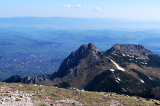 Zakopane is a town in southern Poland with 26,737 inhabitants (end of 2009),
situated in Lesser Poland Province. The town, a place of Góral culture and
informally known as "the winter capital of Poland," lies in the southern part
of the Podhale region at the foot of the Tatra Mountains.
Zakopane is a town in southern Poland with 26,737 inhabitants (end of 2009),
situated in Lesser Poland Province. The town, a place of Góral culture and
informally known as "the winter capital of Poland," lies in the southern part
of the Podhale region at the foot of the Tatra Mountains.
Zakopane has the highest elevation (800-1,000 m) of any town in Poland. The town lies in a large valley between the Tatra Mountains and Gubałówka Hill. It is the most important Polish center of mountaineering and skiing, and is visited annually by some three million tourists. The most important alpine skiing locations are Kasprowy Wierch, Nosal and Gubałówka Hill.
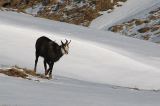 The earliest documents mentioning Zakopane date to the 17th century, describing
a glade named Zakopisko. In 1676 it was a village of 43 inhabitants. In 1824,
together with a section of the Tatra Mountains, it was sold to the Homola
family.
The earliest documents mentioning Zakopane date to the 17th century, describing
a glade named Zakopisko. In 1676 it was a village of 43 inhabitants. In 1824,
together with a section of the Tatra Mountains, it was sold to the Homola
family.
Zakopane's further history was connected with the development of the mining and metallurgy industries in the region - in the 19th century, it was the largest center for metallurgy in Galicia - and later with that of tourism. It grew greatly over the 19th century, as more and more people were attracted by its salubrious climate, and soon developed from a small village into a climatic health resort of 3,000 inhabitants (1889). Rail service to Zakopane began on October 1, 1899. Zakopane was granted municipal rights in 1935.
Read more: Wikipedia · Zakopane · Official Zakopane Website
Tatra Mountains
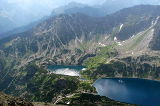 Alps-like Tatra Mountains, or the Tatras (Polish Tatry), is the highest range
of the Carpathian Mountains and lie along Poland's border with Slovakia. Two
hours drive from Krakow one finds stunning views and pristine nature as well as
the best skiing in winter and hiking, rock climbing, cave exploration, cycling,
paragliding, etc. through the rest of the year.
Alps-like Tatra Mountains, or the Tatras (Polish Tatry), is the highest range
of the Carpathian Mountains and lie along Poland's border with Slovakia. Two
hours drive from Krakow one finds stunning views and pristine nature as well as
the best skiing in winter and hiking, rock climbing, cave exploration, cycling,
paragliding, etc. through the rest of the year.
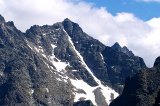 The Tatra Mountains rise to the greatest elevation in the entire northern half
of Europe, with the 2655-meters (8711 ft) Gerlachovsky Stit in Slovakia and the
2499-meters (8198ft) Rysy peak in Poland. The range is 53 km long and takes up
785 sq km, the bulk on the Slovak territory. Three distinct parts make up the
Tatra Mountains - the High Tatras, the Western Tatras, and the Bielskie Tatras.
The High Tatras, with their dramatic vistas, steep peaks, sharp rocks, deep
glens, and crystal lakes are the most attractive. At the same time the Western
Tatras' lower slopes clad in spruce forests offer wider horizons, diverse
wildlife, and somewhat less demanding tracks.
The Tatra Mountains rise to the greatest elevation in the entire northern half
of Europe, with the 2655-meters (8711 ft) Gerlachovsky Stit in Slovakia and the
2499-meters (8198ft) Rysy peak in Poland. The range is 53 km long and takes up
785 sq km, the bulk on the Slovak territory. Three distinct parts make up the
Tatra Mountains - the High Tatras, the Western Tatras, and the Bielskie Tatras.
The High Tatras, with their dramatic vistas, steep peaks, sharp rocks, deep
glens, and crystal lakes are the most attractive. At the same time the Western
Tatras' lower slopes clad in spruce forests offer wider horizons, diverse
wildlife, and somewhat less demanding tracks.
Read more: Tatra Mountains
Tatry National Park
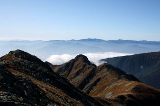 Tatra Mountains National Park has been established in 1954 on the area
protected since 1937. In 1992 the UNESCO proclaimed it the Tatry International
Biosphere Reserve together with the adjacent Tatranski national park of
Slovakia. The flora of Tatry National Park consists in nearly 2,000 species of
plants, including 91 endangered species, some endemic to the Tatra Mountains.
The parkżs vegetation form belts, typical for high mountains, that match
changing climate conditions at different altitudes. Mixed forests reach to
about 1200 meters above sea level, spruce woods up to 1550 meters or so, belt
of dwarf mountain pines up to roughly 1800 meters, alpine grasses to about 2300
meters, and next bare rock with sparse vegetation.
Tatra Mountains National Park has been established in 1954 on the area
protected since 1937. In 1992 the UNESCO proclaimed it the Tatry International
Biosphere Reserve together with the adjacent Tatranski national park of
Slovakia. The flora of Tatry National Park consists in nearly 2,000 species of
plants, including 91 endangered species, some endemic to the Tatra Mountains.
The parkżs vegetation form belts, typical for high mountains, that match
changing climate conditions at different altitudes. Mixed forests reach to
about 1200 meters above sea level, spruce woods up to 1550 meters or so, belt
of dwarf mountain pines up to roughly 1800 meters, alpine grasses to about 2300
meters, and next bare rock with sparse vegetation.
Distinctive plants of the Tatra National Park include limba (stone pine, Pinus cembra) and szarotka (edelweiss, Leontopodium alpinum), and many travel to the park in springtime to see its meadows covered with wild crocuses.
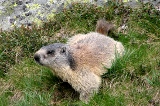 The Tatry Mountains National Park boasts 53 species of mammals including one
endemic rodent (polnik tatrzanski), 101 species of birds, three species of
reptiles, seven species of amphibians, and six species of fish. The park's
emblematic animals are świstak (marmot, Marmota marmota) and kozica (chamois,
Rupicapra rupicapra). Also, its fauna includes brown bear, lynx, deer, and
wolf. Birdwatchers may hope for sightings of orzeł przedni (golden eagle,
Aquila chrysaetos).
The Tatry Mountains National Park boasts 53 species of mammals including one
endemic rodent (polnik tatrzanski), 101 species of birds, three species of
reptiles, seven species of amphibians, and six species of fish. The park's
emblematic animals are świstak (marmot, Marmota marmota) and kozica (chamois,
Rupicapra rupicapra). Also, its fauna includes brown bear, lynx, deer, and
wolf. Birdwatchers may hope for sightings of orzeł przedni (golden eagle,
Aquila chrysaetos).
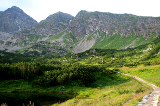 The Tatry National Park also preserves spectacular landscapes typical of high
mountains with sharp peaks, sheer cliffs, moraines, glens, chimneys, gullies,
screes, etc. Plus streams, waterfalls (highest Wielka Siklawa, nearly 70
meters), tarns and lakes (largest Morskie Oko - 34.9 hectares, deepest Wielki
Staw Polski - 79.3 meters). Also caves.
The Tatry National Park also preserves spectacular landscapes typical of high
mountains with sharp peaks, sheer cliffs, moraines, glens, chimneys, gullies,
screes, etc. Plus streams, waterfalls (highest Wielka Siklawa, nearly 70
meters), tarns and lakes (largest Morskie Oko - 34.9 hectares, deepest Wielki
Staw Polski - 79.3 meters). Also caves.
Hiking and trekking trails in the Tatry National Park total 250 kilometers. Most popular destinations are Morskie Oko lake, Giewont peak, and valleys Dolina Kościeliska and Dolina Chochołowska.
Read more: National Parks